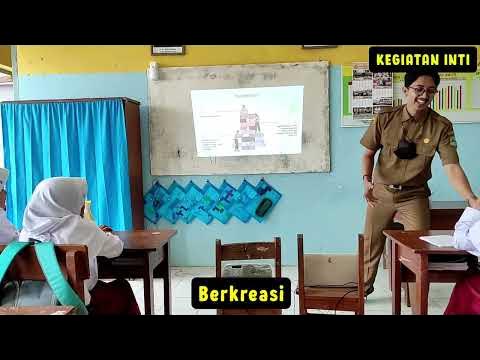Media Pembelajaran | Model ASSURE
Summary
TLDRThis video explores the integration of technology and media in learning, focusing on the ASSURE model. It covers the essential steps for successful learning design, including needs analysis, determining learning objectives, selecting appropriate media and strategies, and ensuring student involvement. The video emphasizes the importance of evaluation and revision to improve learning outcomes. By using the ASSURE model, educators can effectively combine technology and media to create engaging and impactful learning experiences, catering to students' needs and ensuring effective educational delivery.
Takeaways
- 😀 The integration of technology and media in learning requires a thoughtful process, starting with the learning design model.
- 😀 A key step in this integration is conducting a needs analysis to understand the students' characteristics and learning styles.
- 😀 Clear learning objectives must be set, aligned with students' needs, schools, and communities.
- 😀 The selection of appropriate media technology strategies and materials depends on the results of the needs analysis and the learning objectives.
- 😀 The ASSURE model includes six steps for effectively integrating media and technology into the learning process.
- 😀 The first step of the ASSURE model is analyzing the learner's needs and characteristics to guide media and technology choices.
- 😀 The second step is determining clear and specific learning objectives that align with students' needs and desired outcomes.
- 😀 The third step focuses on selecting the most appropriate media, technology, strategies, and materials based on the learning objectives.
- 😀 The fourth step involves implementing the designed strategy and preparing the necessary materials, technology, and environment for effective learning.
- 😀 The involvement of students in the learning process is crucial for effective learning, and activities should provide direct feedback to students.
- 😀 Evaluation and revision of the learning program are essential to measure the effectiveness of the media, the strategies used, and the achievement of learning objectives.
Q & A
What are the key steps in integrating technology and media into learning?
-The key steps are: 1) Learning design model, 2) Needs analysis, 3) Determining learning objectives, 4) Choosing strategy, media, technology, and materials, 5) Implementing the selected strategy, media, technology, and materials, 6) Student involvement in the learning process, and 7) Evaluation and revision of the process.
Why is the ASSURE model recommended for integrating technology and media?
-The ASSURE model is recommended because it explicitly includes the step of selecting media, which other models may not do as clearly. It ensures that the media used is aligned with the learning strategy and objectives.
What does the acronym ASSURE stand for in the context of learning design?
-ASSURE stands for: A - Analyze learners, S - State objectives, S - Select methods, media, and materials, U - Utilize methods, media, and materials, R - Require learner participation, and E - Evaluate and revise.
What is the first step of the ASSURE model and what does it involve?
-The first step is analyzing the learners, which involves identifying the characteristics of students, such as their abilities, skills, and learning styles. This analysis helps in deciding the appropriate media and technology to use.
How do you determine learning objectives in the ASSURE model?
-Learning objectives are determined by considering the needs of students, the standards set by schools, and the expectations of the community. These objectives should align with the students' desired knowledge and skills.
What does selecting media, technology, strategy, and materials involve?
-This step involves choosing the appropriate media, technology, and materials based on the results of the needs analysis and the learning objectives. It ensures that the chosen resources effectively support the learning strategy.
What preparations are required before implementing the selected media and strategy?
-Before implementation, preparations must be made in terms of technology, materials, environment, and student readiness. Additionally, a learning design must be created to guide the students' learning experience.
Why is student involvement important in the learning process?
-Student involvement is crucial because effective learning occurs when students actively participate in their learning. Activities should be designed to provide new knowledge and skills while offering feedback that helps students improve.
What is the purpose of evaluation and revision in the ASSURE model?
-Evaluation and revision aim to assess whether the learning objectives have been met and to determine the effectiveness and efficiency of the media and materials used. This step ensures continuous improvement of the learning process.
What are some learning system designs mentioned in the script for integrating technology and media?
-The script mentions several learning system designs, including models like NKRI, ESSURE, EDDX, AMP, MORE ISLAM, and Rose Benati, all of which can be used for integrating technology and media in learning.
Outlines

This section is available to paid users only. Please upgrade to access this part.
Upgrade NowMindmap

This section is available to paid users only. Please upgrade to access this part.
Upgrade NowKeywords

This section is available to paid users only. Please upgrade to access this part.
Upgrade NowHighlights

This section is available to paid users only. Please upgrade to access this part.
Upgrade NowTranscripts

This section is available to paid users only. Please upgrade to access this part.
Upgrade NowBrowse More Related Video

ASSURE MODEL | Technology for Teaching and Learning | K-Explain #6

RV3 IICTS1 CHAPTER 3

Module 5 Theories and Principles in the Use and Design of Technology Driven Lessons

TEKNOLOGI PENDIDIKAN - Perkembangan teknologi pada bidang pendidikan

Model Pembelajaran Think Pair Share (TPS) Berbasis Sosial Media

7. Choosing media
5.0 / 5 (0 votes)